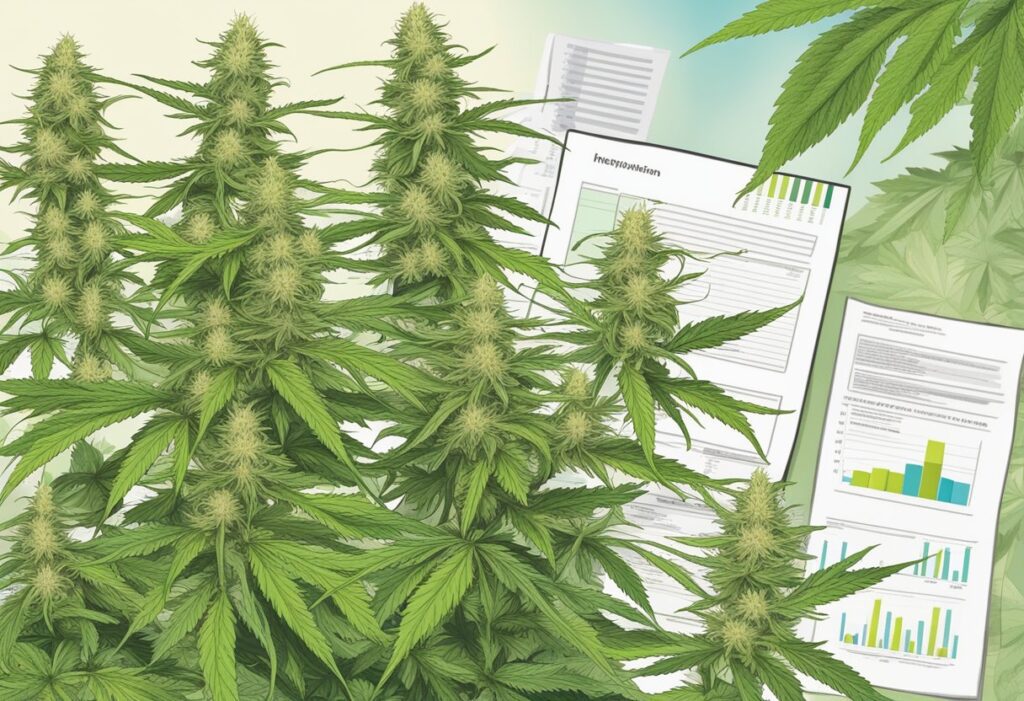
White Widow has been a significant strain in shaping Canada’s cannabis landscape, known for its unique properties that resonate with growers and users alike. Here, we’ll dive into how it emerged in Canadian markets, its cultivation appeal, genetic makeup, and the sensory experience it offers.
White Widow first garnered global attention in the 1990s, originating from the Netherlands. It wasn’t long before its popularity crossed over to Canada, bolstered by its reputation in Amsterdam coffee shops. The legalization of cannabis in Canada in 2018 further solidified White Widow’s position within the Canadian cannabis economy, as it had already established a foothold through both commercial and home cultivation, balancing market share with cultural influence.
You find that White Widow is favored among growers for its hardiness and high yield potential, making it ideal for both novice and experienced cultivators. The strain typically flowers within 50-55 days, with the ability to thrive both indoors and outdoors. It is often highlighted for its notable resilience and impressive trichome production, which not only contributes to its striking appearance but also its potency.
White Widow is a hybrid, born from a cross between a Brazilian Sativa and a South Indian Indica, showcasing a sativa-dominant hybrid balance. It carries a THC content ranging from 18-25%, with low CBD levels. Primary terpenes include myrcene, caryophyllene, and pinene, contributing to its complex botanical profile and ensuring a distinctive and powerful experience.
Your encounter with White Widow is marked by its rich and diverse sensory profile. Users often note the initial pungent, earthy aroma, complemented by underlying notes of citrus and pine. As for taste, expect to detect a peppery scent with a potential for a lemony aftertaste. This complex fusion of flavor and aroma contributes to its enduring popularity among cannabis connoisseurs in Canada.

In Canada, the White Widow strain has played a significant role in both medical therapies and recreational experiences. You’ll see how it aids patients and enthusiasts alike.
White Widow, known for its balancing act of euphoria and relaxation, may contribute notably to medical cannabis use in Canada. Let’s consider some specific benefits:
In terms of mental awareness and focus, White Widow could be particularly helpful. Its balanced effects might enhance your ability to concentrate without the overwhelming sedation some strains induce.
When it comes to recreational use, the White Widow strain tends to deliver an uplifting yet relaxing undertone, making it popular in social settings. Here’s what you might expect:
It’s the uplifting yet relaxing nature of White Widow that may influence your ability to engage socially, making it a favorite for those seeking both a happy camaraderie and a relaxing experience. Whether it’s for a boost in creativity or just to feel at ease in a bustling social environment, you can understand why it’s a popular pick.

Your understanding of the Canadian cannabis market would be incomplete without considering the legacy of the iconic White Widow strain. Known for its balance of sativa and indica properties, White Widow has played a significant role, influencing both legislation and the economic landscape in Canada.
Since Canada’s historic legislation in 2018, legalizing recreational cannabis use, White Widow has been a staple product for cannabis retailers across the country. This hybrid strain, with its Netherlands heritage and potent mix of Brazil Sativa and indica, quickly gained popularity among consumers, necessitating a robust regulatory framework to support safe cultivation and distribution. Canadian provinces have seen a market expansion with growers and retailers capitalizing on the demand for high-quality strains like White Widow, which has been pivotal in setting standards within the industry.
Strains like White Widow appeal to a diverse range of consumers, from medicinal users seeking pain relief to recreational users attracted by its balanced energy and taste profile. This has translated to significant economic prospects:
Demographics Impact:
White Widow’s popularity extends beyond its sale contributions, impacting cultural perspectives. Its quality as a hybrid strain has set a benchmark in the industry, influencing other strains like White Russian and Blue Widow. The cultural significance is evident in Canadian media, with outlets such as CBC News dedicating coverage to the cannabis economy’s growth, reflecting its normalized status post-legalization.
Looking ahead, strains like White Widow serve as a catalyst for innovation within the industry, with anticipated trends including:
Anticipated advancements show promise for Canada’s ability to remain at the forefront of the cannabis market, pioneering both cultivation techniques and consumer experiences.
White Widow, as one of the iconic strains known for its high quality, has contributed to diversifying the market and enhancing consumer choice, subsequently aiding in the economic growth of Canada’s cannabis sector.
White Widow is a popular variety that often features prominently in the product lineups of Canadian cannabis companies, influencing their market share by attracting consumers seeking its unique characteristics.
Yes, the cannabis industry, encompassing strains like White Widow, has been a boon to Canada’s GDP, injecting billions and creating economic ripple effects since its legalization.
The trend for the Canadian cannabis industry, including for strains such as White Widow, points towards sustained growth and diversification, with forecasts promising due to the continuous product innovation and market maturity.
The well-established reputation of strains like White Widow has been instrumental in shaping consumer perceptions and influencing the regulatory framework designed to support a responsible and prosperous cannabis industry in Canada.


WE ARE EVERY GROWERS ONE STOP SHOP TO ACQUIRE PREMIUM CANNABIS SEEDS FOR SALE IN THE USA, CANADA AND AUSTRALIA
Farmers Lab Seeds 2024,
All Right Reserved
Seeds are sold as novelty items, souvenirs, and collectibles. They contain 0% THC. We encourage our customers to check the legislation in their Country, State, Province, and Municipality prior to purchasing items from our store. We do not provide growing information.
All seeds are sold as hemp, and lab tested under 0.3% THC. This product is not for use by or sale to persons under the age of 21. This product should be used only as directed on the label. It should not be used if you are pregnant or nursing. Consult with a physician before use if you have a serious medical condition or use prescription medications. A Doctor’s advice should be sought before using this and any supplemental dietary product. All trademarks and copyrights are property of their respective owners and are not affiliated with nor do they endorse this product.
These statements have not been evaluated by the FDA. This product is not intended to diagnose, treat, cure or prevent any disease. Individual weight loss results will vary. By using this site, you agree to follow the Privacy Policy and all Terms & Conditions printed on this site. Void Where Prohibited by Law.